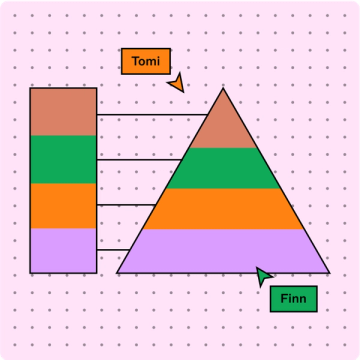What is a strategy map – and how to get started

Many teams have a hard time closing the gap between strategy and execution. That’s when a strategy map can prove useful. Whether you want to boost revenue, improve customer satisfaction, or find better ways to do business, a strategy map can give you a clear picture (literally) of how to achieve your company’s strategic goals.
Read on to learn more about:
- Why a strategy map is useful
- How to create your own
- Jumpstart your strategy map with FigJam
Why you need a strategy map
Mapping the links between business priorities and team functions reveals what your company and its employees need to succeed. A strategy map also highlights intangible assets driving business success, like innovative company culture or great customer relationships. Your strategy map can help your entire organization understand and collaborate on business initiatives, showing how cross-functional teamwork helps to achieve shared goals.
Start strategic planning today
Want to start your own strategic planning? Get started with FigJam's free templates today.
Map your strategy in 6 steps
Strategy mapping takes some planning and effort, but you can jumpstart your strategy map with these six steps.
- Review your mission, vision, and values. If your company hasn't already hammered out its mission, vision, and values, FigJam has a template to help define them. Think about your company’s aspirations, purpose, and beliefs. Do they still work in the current business environment? Do they represent all key players involved, including customers, shareholders, and employees?
- Define your strategic initiatives, objectives, and goals. First, state your financial and customer objectives and goals (what you’re trying to achieve). Then, outline internal process initiatives and learning and growth activities (what you need to do to achieve your goals). Bring in company stakeholders to help set priorities.
- Create a diagram linking strategic actions and goals. On your strategy map, show cause-and-effect relationships. On this strategy map example from Harvard Business Review, you can see how learning and growth fuels internal processes, which in turn support customers and ultimately financial goals.
- Apply key metrics to measure performance. Use a mix of leading and lagging KPIs (key performance indicators) to help teams track how they’re doing against the objectives and goals in the strategy map. Leading indicators help predict where a company is headed, such as the number of unique website visitors, percent of customer signups, and number of products purchased. Lagging indicators focus on actual results like annual revenue, number of customers, and renewal rates.
- Share and adapt your strategy map. For a business to succeed, everyone needs to get up to speed, involved, and excited about the company’s direction. Once you’ve shared the overall business strategy map, teams companywide—from sales, marketing, and product to UX, IT, and customer service—can develop their own detailed strategy maps to sync up with the high-level one.
- Revise your strategy map as needed. When business priorities change due to a new opportunity or unforeseen market shifts, make the necessary changes to your strategy map. Just be sure updates are communicated companywide.
Track 4 key success factors on your strategy map
According to the balanced scorecard approach, a strategy map covers four key factors for success in any business:
- Financial. Business strategy typically involves maximizing value for shareholders through revenue growth (e.g., picking up new customers) and productivity (e.g., reducing company costs).
- Customer. This is where your unique customer value proposition comes in. Do you want to achieve operational excellence (e.g., on-time delivery), customer loyalty (e.g., top-notch service), or product leadership (e.g., cutting-edge features)? You could go for all three—but choose one as your top priority.
- Internal process. Think about how internal business processes support your customer and financial goals. What processes are key to new product innovation, customer relationship management, operations and logistics, or corporate responsibility?
- Learning and growth. Do you have the right people with the right skills to grow your business? Are your technology solutions meeting your needs? What about your company culture—is it working for you or against you? Put the right people, skills, technology, and culture in place to bring your strategy to life.
3 pro tips for smart strategy maps
- Make it a one-pager. To make your strategy map easy to follow, try to make it fit on one page. On your map, include 12 to 18 strategic objectives that apspan financial, customer, internal process, and learning and growth. Keep objectives brief, with short phrases like “increase shareholder value,” “delight customers,” and “reduce cost per customer."
- Apply your SWOT analysis. Identify and evaluate your company's strengths, weaknesses, opportunities, and threats (SWOT) before making your strategy map. This analysis uncovers key factors that can help or harm your business, which can shape your strategy. FigJam’s SWOT analysis template will help you kick things off.
- Adapt as you grow. Strategy maps are helpful communication and collaboration tools for businesses of all sizes. They help everyone understand their roles in meeting strategic business goals. To capture new opportunities and market shifts, check out FigJam’s 60-plus strategic planning templates.
Jumpstart your strategy map with FigJam
Don't overthink it: you and your team can start outlining your strategy today with FigJam's collaborative online whiteboard. Then you can map your strategy, using our free FigJam diagramming tools to:
- Create presentation-ready diagrams. Drag and drop shapes and arrows with our intuitive interface.
- Collaborate with key stakeholders. Get feedback whenever you're ready by sharing a link to your diagram.
- Grab designs from your Figma library. Polish your FigJam file with branded design elements from your Figma library.
Ready to build your strategy map? Let's go!
Check out this handy how-to video on building diagrams from scratch in FigJam. For inspiration, browse FigJam’s library of diagramming templates. Or just dive in—you've got all the info and the tools you need, right here.
Sources
[1] https://hbr.org/2000/09/having-trouble-with-your-strategy-then-map-it
[2] https://www.investopedia.com/terms/b/balancedscorecard.asp
[3] https://hbr.org/2000/09/having-trouble-with-your-strategy-then-map-it
[4] https://www.investopedia.com/terms/k/kpi.asp
[5] https://www.linkedin.com/pulse/communicating-your-strategic-plan-employees-david-grossman/
[6] https://www.gartner.com/smarterwithgartner/the-five-pillars-of-strategy-execution
[7] https://balancedscorecard.org/bsc-basics/what-is-a-strategy-map/
Keep reading

Strategic vs. tactical planning
While strategic planning involves big-picture thinking, tactical planning covers the nitty-gritty of turning strategy into action.
Mehr erfahren

Strategic planning process in 6 steps
Every business needs a great strategic plan to achieve their long term goals.
Mehr erfahren

What is strategic planning
What is strategic planning and why is it more important?
Mehr erfahren




